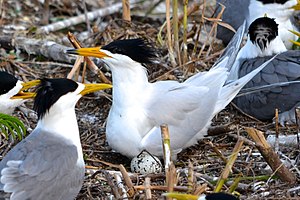Amber tern
| Amber tern | ||||||||||
|---|---|---|---|---|---|---|---|---|---|---|

Amber tern ( Thalasseus bernsteini ) |
||||||||||
| Systematics | ||||||||||
|
||||||||||
| Scientific name | ||||||||||
| Thalasseus amberi | ||||||||||
| ( Schlegel , 1863) |
The Amber Tern ( Thalasseus bernsteini ) is an extremely rare seabird from China and Taiwan . It was previously classified in the genus Sterna . Due to a revision in 2005, it now belongs to the genus Thalasseus . The specific epithet honors Heinrich Agathon Bernstein , who collected the type specimen for Hermann Schlegel .
description
This slim, large tern reaches a length of 43 cm. It has a black hood , and generally white plumage with pale gray wings. In flight, there is a sharp contrast between the pale gray upper wings and the black outer hand wings. The beak is amber with a black tip.
distribution
The amber tern used to be common along the coasts of China, Taiwan, Thailand , Halmahera , Malaysia , Sarawak, and the Philippines . Today it only occurs on small offshore islands off Taiwan.
Danger
In June and July 1937, 21 specimens were collected on a small island off the coast of Shandong . It was then considered extinct. In 1978 and 1991 there were unconfirmed reports of sightings in Hebei and Shandong. In June 2000, however, a Chinese scientist discovered and filmed four pairs and four juveniles in a group of other species of tern on the Matsu Islands in the Taiwan Strait .
It is considered the rarest tern in the world with a population of less than 50 specimens. Little is known about the exact cause of their rarity and their way of life. The wetlands in which their breeding grounds were located had to give way to agricultural use in many places. In addition, tern eggs are considered a delicacy in China. Today the area in which the new colony was discovered is under strict nature protection. Other areas such as the Sanjiaozhou Nature Reserve in Shandong and the Laem Talumphuk Non-Hunting Area in Thailand, where this species was common in the past, are also strictly protected. In 2007 BirdLife International sounded the alarm because, despite protective measures, the eggs are being collected relentlessly and the species is therefore likely to be extinct within the next five years.
In 2010 it was possible to photograph specimens for the first time in the Indonesian wintering area on Pulau Lusaolate north of Seram .
Web links
- BirdLife International: Species Factsheet - Thalasseus bernsteini
- Thalasseus bernsteini in the endangered Red List species the IUCN 2008. Posted by: BirdLife International, 2008. Accessed on December 20 of 2008.